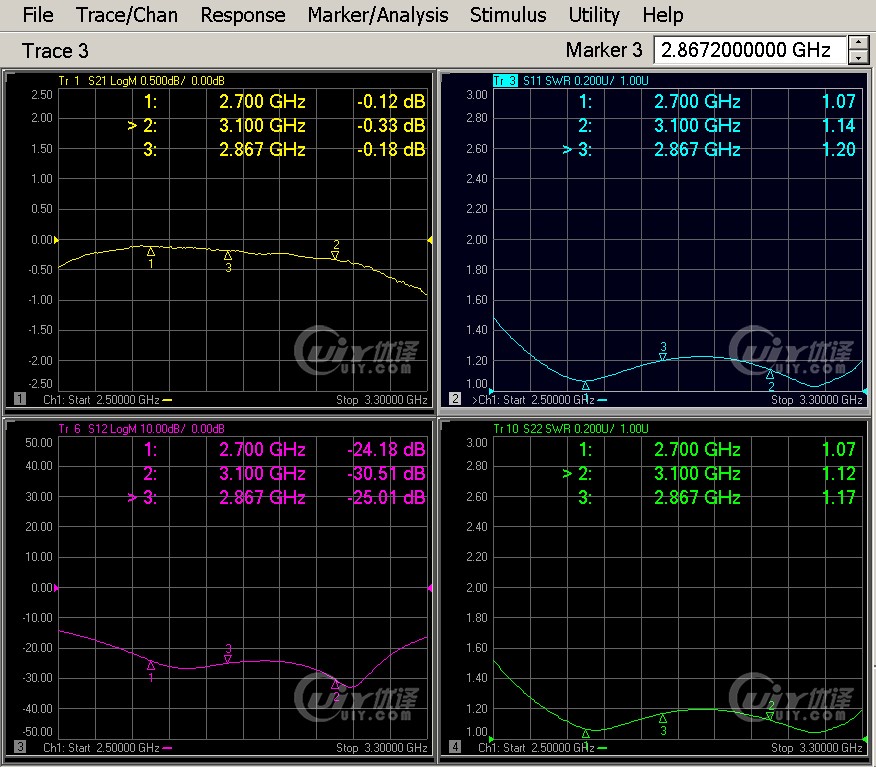The reverse power (or reflected power) is the sum of all the power output from the device to the capacitor plate or the inductor coil, including the effective power absorbed by the load and the reflected power not absorbed. Usually recorded as Pr.
The measurement of reverse power is an important part of network measurement. For RF signals, reflections occur when the impedances of two connected devices differ. Reflection measurement is to measure the ratio relationship between the reflected signal and the input signal.
A network analyzer uses the R receiver to measure the input signal and the A receiver to measure the reflected signal, so reflection measurements are often expressed as the ratio of A to R (A/R), and we can use the amplitude and phase information of the A and R receiver signals fully quantitatively characterize the reflection characteristics of the DUT.
In S-parameter terms, S11 represents the reflection from DUT port 1 (input port), and S22 represents the reflection from DUT port 2 (output port). The purpose of reflection measurement is to ensure the effective transmission of RF energy. If the energy is reflected, it means that very little energy is transmitted to the target place; in addition, if the reflected energy is too large, it may burn the device, such as the output power amplifier.
The Reverse Power Factor:
| SWR | Reverse Power (%) |
| 1.0 | 0.0000 |
| 1.1 | 0.2268 |
| 1.2 | 0.8264 |
| 1.3 | 1.7013 |
| 1.4 | 2.7778 |
| 1.5 | 4.0000 |
Surface Mount Circulator RF characteristics
| Model Number | Freq.Range
(MHz) |
Insertion Loss Max(dB) |
Isolation Min (dB) |
VSWR Max |
Forward Power (W) | Reverse Power (W) | Connector
Type |
Temp. (°C) |
| UIYSC12A1805T2170 | 1805~2170 | 0.5 | 18 | 1.3 | 30 | 30 | SMT | -40~+85 |
| UIYSC12A1920T1990 | 1920~1990 | 0.3 | 23 | 1.2 | 30 | 30 | SMT | -40~+85 |
| UIYSC12A2110T2170 | 2110~2170 | 0.3 | 23 | 1.2 | 30 | 30 | SMT | -40~+85 |
| UIYSC12A2300T2500 | 2300~2500 | 0.3 | 23 | 1.2 | 30 | 30 | SMT | -40~+85 |
| UIYSC12A2400T2600 | 2400~2600 | 0.3 | 23 | 1.2 | 30 | 30 | SMT | -40~+85 |
| UIYSC12A2496T2690 | 2496~2690 | 0.3 | 23 | 1.2 | 30 | 30 | SMT | -40~+85 |
| UIYSC12A2500T2700 | 2500~2700 | 0.3 | 23 | 1.2 | 30 | 30 | SMT | -40~+85 |
| UIYSC12A2700T3100 | 2700~3100 | 0.4 | 21 | 1.25 | 30 | 30 | SMT | -40~+85 |
| UIYSC12A2900T3300 | 2900~3300 | 0.4 | 20 | 1.25 | 30 | 30 | SMT | -40~+85 |
| UIYSC12A1805T2170 | 1805 ~2170 | 0.5 | 18 | 1.3 | 30 | 30 | SMT | -40~+85 |
Surface Mount Isolator RF characteristics
| Model Number | Freq.Range
(MHz) |
Insertion Loss Max(dB) |
Isolation Min(dB) |
VSWR Max |
Forward Power (W) | Reverse Power (W) | Connector
Type |
Temp. (°C) |
| UIYSI12A1805T2170 | 1805 ~ 2170 | 0.5 | 18 | 1.3 | 30 | 10 | SMT | -40 ~+85 |
| UIYSI12A1805T1880 | 1805 ~ 1880 | 0.3 | 23 | 1.2 | 30 | 10 | SMT | -40 ~+85 |
| UIYSI12A1920T1990 | 1920 ~ 1990 | 0.3 | 23 | 1.2 | 30 | 10 | SMT | -40 ~+85 |
| UIYSI12A2110T2170 | 2110 ~ 2170 | 0.3 | 23 | 1.2 | 30 | 10 | SMT | -40 ~+85 |
| UIYSI12A2300T2500 | 2300 ~ 2500 | 0.3 | 23 | 1.2 | 30 | 10 | SMT | -40 ~+85 |
| UIYSI12A2400T2600 | 2400 ~ 2600 | 0.3 | 23 | 1.2 | 30 | 10 | SMT | -40 ~+85 |
| UIYSI12A2496T2690 | 2496 ~ 2690 | 0.3 | 23 | 1.2 | 30 | 10 | SMT | -40 ~+85 |
| UIYSI12A2500T2700 | 2500 ~ 2700 | 0.3 | 23 | 1.2 | 30 | 10 | SMT | -40 ~+85 |
| UIYSI12A2700T3100 | 2700 ~ 3100 | 0.4 | 21 | 1.2 | 30 | 10 | SMT | -40 ~+85 |
| UIYSI12A2900T3300 | 2900 ~ 3300 | 0.4 | 20 | 1.25 | 30 | 10 | SMT | -40 ~+85 |
| UIYSI12A1805T2170 | 1805 ~ 2170 | 0.5 | 18 | 1.3 | 30 | 10 | SMT | -40 ~+85 |
| UIYSI12A1805T1880 | 1805 ~ 1880 | 0.3 | 23 | 1.2 | 30 | 10 | SMT | -40 ~+85 |
| UIYSI12A1920T1990 | 1920 ~ 1990 | 0.3 | 23 | 1.2 | 30 | 10 | SMT | -40 ~+85 |




